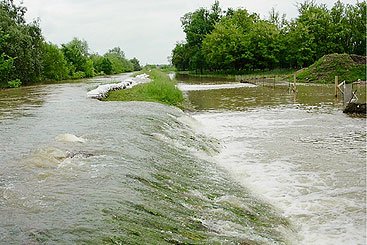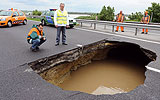Flood management: Danube countries taking action against rising waters

Flood management:
Danube countries
taking action against rising waters
While flood risk management means cooperative planning, countries around the region are putting ideas into action to protect themselves against threatening waters.

Flood management plans are going into action throughout the basin, as Danube countries are turning policies and strategies into structures and rehabilitation.
In 2009, the ICPDR published 17 sub-basin flood action plans covering the entire Danube catchment area, fulfilling a key milestone of the ICPDR’s Action Programme for Sustainable Flood Protection in the Danube River Basin. These plans represent unique technical planning documents providing a broad overview of the measures the Danube countries will be taking to protect their citizens against the flood risks. They are also a good basis for the preparation of flood risk management plans as required by the EU Floods Directive.
However, flood risk management in the Danube River Basin does not mean only planning future actions. Remarkable achievements in flood protection, prevention and mitigation have already been made in all Danube countries as a result of the national strategies of management of flood risks as well as a response to the ICPDR Action Programme.
New structures for protection. The upgrade of the Vásárhelyi Plan for the Tisza River in Hungary included construction of two flood retention basins. The polders Cigánd-Tiszakarádi (finished in 2008) and Tiszaroffi (finished in 2009) have a total volume of 191 million m³ that can be employed to reduce the flood peak on the Tisza. The construction of two new flood retention basins, Hany-Tiszasüly (247 million m³) and the Nagykunsági (99 million m³), began in 2009.
Between 2002 and 2007, the Czech Ministry of Agriculture ran a programme on Flood Prevention, and in the frame of this activity 75 structural flood protection measures were built in the Morava River Basin by the river administrations with the costs amounting to 1.5 billion CZK. In Slovakia a number of structural flood protection projects have also been completed in recent years including construction of new and reconstruction of existing flood protection lines as well as the modernisation of flood protection dykes.
Ukraine spent 431 million UAH in 2006-2009 under the framework of the ‘Complex Program on Flood Protection in the Tisza River Basin in Transcarpathia until 2015’ to implement structural measures: 104.8 km of protective dikes were reconstructed and 44.8 km of bank protection structures were constructed. This has enabled 73 settlements and 52,300 hectares of agricultural lands to be protected.
Investing in effective measures. Under the ‘Flood Protection Action Programme 2020’, Bavaria spends approximately €115 million each year on flood protection (during 2006-2008 the annual budget stretched to €150 million). Approximately 75% of that budget is invested in the Danube catchment area. These investments increased flood risk protection for an additional 200,000 citizens during 2001-2005. In 2007 the polder ‘Weidachwiesen’ at the Iller River was completed as the first controlled flood polder in Bavaria with a retention volume of approximately 6.3 million m³.
Austria adopted the ‘Flood Programme 2016’, whose main goals were to improve existing measures or create new flood protection measures, both structural as well as non-structural, and to accelerate the preparation of flood hazards maps. Based on this programme Austria invests about €400 million per year into flood protection measures. An Austria-wide internet platform for natural hazards has been developed (www.hochwasserrisiko.at), in which all areas potentially affected by floods are shown.
Drafting plans to minimise risk. Using a Swedish support the Directorate for Water in Serbia developed a draft of the Flood Risk Management Plan for Tamnava River Basin in June 2010. All phases of flood risk management planning as required by the EU Floods Directive were successfully accomplished; this involved many stakeholders at national and local level.

Flood hazard maps can help governments make decisions about land use and development to protect people living in the hardest hit areas.
Romanian authorities regularly update the flood protection plans, which are prepared at several levels. In March 2010 these plans were revised to include the necessary actions for 2010-2013, and for the first time they include the inundation areas presented in a GIS format showing historical data as well as the floods with different probabilities.
New legislation was adopted in Slovenia, to define the national methodology for flood hazard and flood risk mapping, and set the preventive rules for urban planning and construction of buildings in flood hazard areas.
Rehabilitating the river’s own systems. In Croatia, large alluvial wetlands have been preserved in the Central Sava Basin to reduce the maximum peaks of the Sava and Kupa Rivers during high water. This concept has proved very effective and it is an excellent model for flood-control systems: the retention areas not only reduce flood risks, they also maintain a high biological diversity in the region. The whole wetland system, though not fully completed, has proved to be very effective in recent years, protecting the major municipalities such as Zagreb, Karlovac and Sisak, and large agricultural areas, against flooding.
In Bulgaria, a project called ‘Rehabilitation and Strengthening of River and Coastal Banks on the Black Sea and the Danube’ was completed in 2009, focusing on the protection of the Danube banks against erosion, to prevent the adjacent areas from a possible flood risk.
Updating emergency systems. An improvement to the early warning system monitoring the accidental pollution as well as water level has been carried out in Bosnia and Herzegovina. There are two automatic hydrological monitoring stations in operation on the Sava River in Bosnia and Herzegovina and 15 other hydrological and meteorological automatic monitoring stations on the major tributaries of the Sava River.
The above actions are only a few examples of tangible
achievements resulting from flood protection policies
in the Danube countries. The ICPDR regularly
publishes the ‘Report on Achievements in Flood Protection
in the Danube River Basin’, an overview of
the successes in flood risk management in this area.
The latest update was issued in December 2010 and is
available on: www.icpdr.org.





